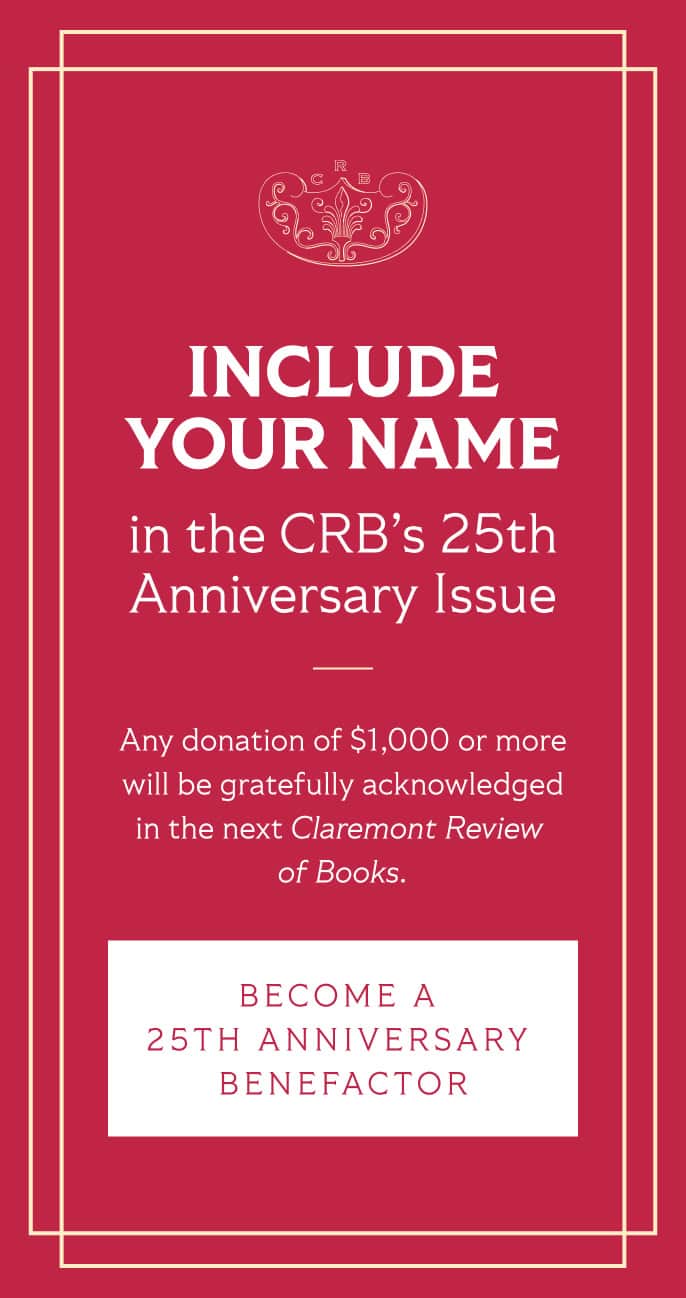Books Reviewed
It was probably inevitable that eventually an academic would rewrite the history of the American Founding in his own image. Bruce Ackerman, Sterling Professor of Law and Political Science at Yale University, has selected, molded, distorted, and recreated the events of the 1800 election and its aftermath to suit his view of what the Constitution ought to be. It’s a pity. Written with a vibrant narrative style, The Failure of the Founding Fathers highlights such overlooked or underappreciated facts as the framers’ lack of judgment in putting the vice president in charge of counting electoral votes, and the truly heroic efforts of Federalist Congressman James Bayard to break the famous impasse between Thomas Jefferson and Aaron Burr.
Nonetheless, the book fails because it is not a work of history at all, but rather an argument constructed to advance an ideological and political agenda. Ackerman wants to delegitimize the Electoral College and to undermine the founders’ authority. This is part of his larger project, begun with his We the People series (Volume 1: Foundations, 1991; Volume 2: Transformations, 1998), to deconstruct American constitutional law and strip any normative authority from the original document. In 2001, he famously argued that the Senate should not confirm any of George W. Bush’s future Supreme Court nominations because of the Court’s “vulgar partisanship” in Bush v. Gore, which had enabled Bush to gain Florida’s electors and so win the presidency, though without carrying the popular vote.
Ackerman is well aware that originalism has gained the high ground in constitutional interpretation and that its opponents often have been reduced to fighting rear-guard actions based on stare decisis or, at best, to making tactical advances under such opportunistic rubrics as “active liberty.” He knows that academic scholarship on the founding has reached such a high level of sophistication that it has been used to understand and decide constitutional cases. He also knows that popular interest in the founders’ lives has produced a score of recent bestsellers by respected historians. So Ackerman has gone for the nuclear option: undermine originalism by picturing the founders as nothing more than an 18th-century version of Tammany Hall.
The Electoral College stands in the way of a popularly elected president. But this barrier was weakened, though not entirely dismantled, by the “revolution of 1800.” The admitted flaw in the original version of the Electoral College left Jefferson and Burr tied for the presidency and threw the election into the House, where the lame-duck Federalist Congress sought to turn the result to its party’s advantage. Jefferson insisted that “the people” had spoken and that their decision should be honored. According to Ackerman, the denouement was the struggle between Jefferson and Chief Justice John Marshall that led to a new synthesis between the formalistic Constitution and the “plebiscitary” presidency. This new synthesis, which the author calls (not too subtly) the “living” Constitution, broke free from those parts of the 1787 Constitution that had proven contrary to the needs of the developing polity.
On the way to that conclusion, the book is strewn with an astonishing number of historical omissions, mischaracterizations, misinterpretations, and misunderstandings. To begin with, Ackerman’s use of “plebiscitary” to describe the presidency established by the 1800 election is historically inaccurate, implying something like a Napoleonic outcome. Years before, in 1783, George Washington had vehemently rejected such a Napoleonic scenario when some of his officers had proposed marching on Congress and making him king—a stroke that might have been enthusiastically approved by “the people.” Far from lusting for power, Washington regarded his unanimous elections to the presidency as a call to duty, which he reluctantly, but with complete dedication to republican virtue, accepted.
Of course, many of his opponents suspected Jefferson himself of harboring Napoleonic ambitions. After all, he strove mightily through most of his presidency to create a one-party state, and he was not shy, as historian Forrest McDonald points out, to use the American army against the people in enforcing the disastrous 1807 Embargo. During the uncertain days of early 1801, Jefferson warned that if the House denied him the presidency, armed militias might march on Washington and establish a new constitutional convention (and a new form of government). Nonetheless, not even Jefferson claimed to have been elected in 1800 because of the popular vote. Rather, he insisted that he was president because of the electoral vote, and it was only a glitch in the Constitution’s original mechanism (he and his would-be vice president, Aaron Burr, had tied in the Electoral College) that had permitted a dastardly Federalist Congress to try to frustrate the will of the electors. Jefferson’s electoral majority (along with Burr’s) had included votes from states whose legislatures, not whose voters, had chosen the electors who in turn voted for Jefferson. He never claimed victory until the South Carolina legislature (which many thought would opt for Adams) chose Jeffersonian electors in December 1800 and put him and Burr over the top. In other words, in the 1800 election, Jefferson was an originalist. He believed, as did the framers, that the first choice of the electors should be president.
* * *
The Jeffersonian Republicans in Congress soon corrected the glitch with the 12th Amendment, which had directed electors to vote separately for the president and the vice president. Ackerman is disappointed that they did not opt for a wholesale change (or even abolition) of the Electoral College. But the reason is absolutely clear and flies in the face of Ackerman’s central thesis. Even the Republicans did not want a plebiscitary presidency. They wanted to effectuate the will of the framers through a modest change in the electoral mechanism, which would, at the same time, accommodate the rise of political parties.
At bottom, Ackerman simply does not understand the full reason for the Electoral College. He correctly points out that one of its purposes was to distance the selection of the president from the passions and intrigues of faction; and he claims that with the rise of parties, this “filtering” function was largely vitiated. But not entirely. One of the post-1800 Electoral College’s salutary accomplishments is that it provided a clearly legitimate president when the party system had broken down, e.g., in 1860 and 1912. Moreover, political scientists have long demonstrated that the Electoral College, with the developing tradition of winner-take-all in each state, works against a multiplicity of parties. The mechanism actually forces parties to seek coalitions among factions, thereby mitigating faction’s deleterious effects and fulfilling the original purpose that the framers had in mind.
Furthermore, the Electoral College is another example of the framers’ plan to include the states in the structure of the central government. As the Constitutional Convention progressed, the delegates realized that it was not enough to divide power between the central government and the states. By itself, that would inevitably engender serious conflict. Instead, the framers included the states as constituent elements in the central government. It was the people of the several states that ratified the Constitution. It would be the states, in one form or another, that would have to agree to amendments. The states would select the senators, and determine who could vote for the House of Representatives. They would set the time, place, and manner of holding federal elections (subject to congressional override). Even in the House, members had to reside in the states from which they were elected. The states would provide the militia needed by the central government. The states would determine how and when presidential electors would be chosen, and the electors would cast their votes in their respective state capitals. And if the Electoral College failed to reach a majority, the House of Representatives, voting as states, would determine the result. In his lifelong drive to interpret American government along the lines of majoritarian democracy, Ackerman is necessarily oblivious to the essential role of the states in the central government’s structuring.
He seems not to appreciate sufficiently the reason why a fail-safe provision was inserted into the Constitution to have the House members vote as states. In many instances, such as in the Senate and the Electoral College (as well as in the amending process), the small states, for their protection, are overrepresented. Particularly in electing a president, where the large states would have an advantage (our first six presidents came from large states), providing each state with electoral votes equal to the number of its representatives and senators gives the small states a statistically significant advantage. This advantage is carried over into the House of Representatives if called upon to elect a president. This device actually prevented the lame-duck Federalist majority in the House from substituting Aaron Burr for Thomas Jefferson, a result that, as Ackerman properly notes, almost certainly would have led to a catastrophic constitutional crisis.
* * *
The book’s harshest criticism is reserved for John Marshall. Based on supposition, innuendo, questionable sources, and cheap rhetoric, Ackerman makes Marshall the piece’s villain, whose only saving grace was to make a tactical retreat in the face of Jefferson’s victory. (While castigating Marshall, Ackerman goes out of his way to praise Aaron Burr’s “statesmanship.”)
Readers will not find here the Marshall so meticulously researched and elucidated in Jean Edward Smith’s John Marshall: Definer of a Nation (1996), or in any of the other reputable biographies now available. Impugning Marshall’s character allows Ackerman to indict one of originalism’s signal heroes. He claims, for example, that Marshall possessed a “lust for power,” that he was a “blinkered partisan.” Both insults are unfounded. Marshall was well known for having turned down many offers of governmental position. Nearly all who dealt with him regarded him as a capacious personality, accommodating to the wants and opinions of others. In the seminal case of Marbury v. Madison (1803), he eschewed an interpretation of the 1789 Judiciary Act that would have threatened the separation of powers. It was his central purpose in Marbury to withdraw the Court from partisan involvement altogether (see my “The True Story of Marbury v. Madison,” in CRB, Winter 2003). This was the opposite of a grab for power: Marbury embodied the practice of republican virtue in the judiciary. Ackerman’s attack on Marshall’s handling of William Marbury’s commission is an astonishing combination of invective and historical error. In fact, virtually all of Ackerman’s understanding of Marbury comes from out-of-date scholarship. Thus he reports, for example, that Jefferson ordered Madison not to deliver the commission, when Madison was not even in town.
Although The Failure of the Founding Fathers offers a few insights, it is absolutely blind to notions of character. But one cannot understand the American Revolution, the framing of the Constitution, the ratification struggles, or the Federalist-Republican conflict without taking seriously the idea of public virtue. The struggles between Madison and Hamilton, or between Adams and Jefferson, may have been triggered by policy differences, but the heart of these and other divisions was the belief that the other man had lost his virtue. The fact is that neither the Federalists in the judiciary nor the Republicans in Congress accepted the idea of a “plebiscitary” presidency because it contradicted all their notions of republican integrity and self-control. In the end, it was the framers’ original vision that rightly triumphed.






